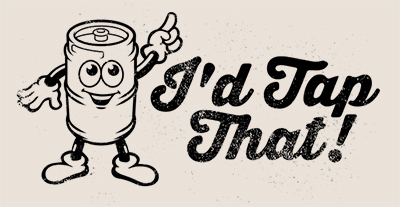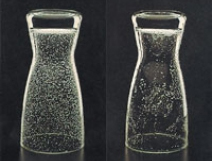| Tapping the Perfect Keg  Achieve the perfect pour! Achieve the perfect pour!
The good people at Redswhitesandbrews want to help you enjoy the full potential of draught beer. It’s all about easy serving, no bottles or cans, no fuss, no muss, just great tasting fresh beer every time. That’s why we created this section to provide you with tips on handling and dispensing the perfect draught beer. Cheers! Our draft beer has no preservatives and is not pasteurized. It should be stored at 3 to 4 Celsius at all times. A few tips to help you maintain the highest quality and freshness:- Keg storage and dispensing areas should be kept clean to minimize any possibility of contaminating your draught products.
- Be sure to store packaged beer in a cool, dark place. (But not too cold – frozen beer takes on a cloudy appearance and shouldn’t be served.) In most cases, beer exposed to high temperatures or direct sunlight will lose its flavor
- Draught beer should always be refrigerated. Ideal temperature should be between 1 - 3°C (34-38°F).
- To avoid the problem of too much foam that can occur from agitation during transit, kegs should remain stationary 24 hours after you receive them. Store draught beer in a refrigerated walk-in cooler or a refrigerated cabinet immediately.
- Keep coolers running at all times and shut down refrigeration for servicing only.
- Keep keg storage and dispensing area clean to prevent contaminating draught products.
Keep you lines clean:- Your lines should be cleaned on a regular basis. Why? It’s all because of a scale called calcium oxalate, commonly referred to as 'beerstone', that forms on the fittings, lines and taps. If you don’t remove this beerstone, it will leave an unsanitary surface that can harbour micro-organisms which can affect the quality and taste of your beer, as well as affect its shelf life.
- Proper line cleaning will eliminate the build-up, protecting the integrity of the product. Depending on the type of dispensing system you have, line cleaning should be done on a regular basis.
- For more information contact our friendly staff to provide you with information on the program best suited to your needs.
Helpful hints on controlling temperature:- It’s important to store and dispense draught beer at the correct temperature, 34-38°F (1-3°C). If it’s too cool or too warm, it could cause flavour loss and dispensing problems.
- Keep a thermometer handy to monitor temperature of draught in your cooler and at the tap
- Keep cooler door closed as much as possible to avoid temperature fluctuation
- Regular maintenance of refrigeration equipment is recommend
Dispensing pressures differ according to:- The type of draught dispensing system
- The length of draught dispensing line
- The temperature of the product
- The pressure source: air pressure, CO2 or special blended gases
Helpful hints on maintaining the correct pressure:- Monitor your regulators to ensure applied pressure remains constant
- Keep equipment in good repair
- Redswhitesandbrews beer generally pours best between 5 and 10 psi.
Helpful hints on tapping the keg:- Be careful not to agitate the kegs unnecessarily. If this happens, allow kegs to settle for 1-2 hours before tapping.
- Before you tap the keg, ensure that all beer faucets in the serving location are in the off position.
- Remove the dust cover (identification cap) from the keg. Check that the keg coupler is in the up (off) position.
- Insert the coupler into the valve on top of the keg and turn ¼ turn clockwise.
- To start beer flow, pull out the coupler handle and press downward into the lock (on) position. The keg is now tapped.
Tips on Freshness:- Keep kegs refrigerated at all times. As a food product, we recommend that beer should be kept refrigerated at 34 - 38°F (1 - 3°C) at all times.
- Stored at the recommended temperature, kegs should be used by the production date stamped on the keg itself or on a label.
- Never let beer lines empty or allow them to dry out.
- If compressed air is used, the tapped keg should be used up in 4 days or less. Air causes beer to go stale and it takes on an unpleasant taste and appearance.
How to Serve the Perfect Glass: 
Keeping your glassware 'beer-clean' is key to serving the perfect draught. - Always keep your glass washing area extremely clean.
- Never wash glassware with utensils or dishes used to serve food. Food particles and/or residue can affect draught quality.
- Use a detergent designed specifically for beer glass cleaning (low-suds, odour-free and non-fat. Do not use regular liquid household dishwashing detergents for glassware).
- Place glassware upside-down on a deeply corrugated drainboard to dry so that air can circulate freely inside the glasses. Flat counter tops used for food preparation and serving are a potential source of contamination.
- Never dry glassware with a towel.
- We recommend that you use beer glassware only for beer. Dairy and other food products leave a residue which can affect the quality of the draught.
- Store glasses at counter height or lower. Cigarette smoke, cooking odours and grease odours tend to rise.
- If you have overhead glass racks, use them for liquor and cocktail glasses. These drinks are not affected the same way as draught beer.
Tests to ensure you’re pouring beer-clean: 1 | Sheeting Test
A beer-clean glass will shed water evenly in unbroken “sheets”. On a glass with invisible film, water will break up and form droplets on the surface of the glass. | 2 | Salt Test
In a beer-clean glass, salt sprinkled on the interior of a wet glass will adhere evenly. If not properly cleaned, salt will fall to the bottom or adhere in a random pattern. Salt will not stick wherever a greasy film is present. | 3 | Head Retention Test
A beer-clean glass will form a thick, tightly-knit, creamy head. The beer will be sparkling-clear and free of bubbles. A glass that’s not properly cleaned will have loose, large bubbles (fish eyes) that will cause the head to disappear within 10-60 seconds. Bubbles will visibly rise from the bottom of the glass and adhere to the sides. | 4 | Lacing Test
In a beer-clean glass, foam will adhere to the inside, forming a parallel ring pattern (lacing) as each sip of beer is taken. In a glass that is not properly cleaned, foam (if there is any) will adhere to the glass in a loose, random pattern – or may not adhere at all. |
Draught Beer ChecklistSome common problems to watch for with your draught beer. If the beer is FOAMY, check:- That the beer faucet is being opened completely
- That the beer is being poured to minimize foaming and waste
- That the beer faucet is clean – obstructions can agitate the flow of beer
- That the flow rate is approximately 5 seconds for a 10 oz glass
- If beer is poured too slowly or too quickly, adjust pressure as required to see if problem is corrected
- That you are following proper tapping procedures
If the beer is CLOUDY, check:- That you are using the right level and brand of detergent to clean beer glasses
- That your cooler temperature is correct and the right temperature of beer at the dispensing faucet
If your beer is FLAT, check:- That your glassware is beer-clean
- That the temperature of your cooler and the temperature of beer at dispensing faucet is correct. The ideal temperature is 34 to 38°F (1 to 3°C).
- That the flow rate is approximately 5 seconds for a 10 oz glass
- If beer is pouring too slowly or too quickly, adjust pressure as needed
- That you are following proper tapping procedures
- That you use the recommended pressure source for dispensing your style and type of draught beer (air pressure, CO2 or special blended gasses), and that the air compressor has a source of clean “grease free” air
For OFF-TASTE BEER, check:- That the temperature of your cooler and the temperature of beer at dispensing faucet is correct. The ideal temperature is 34 to 38°F (1 to 3°C).
- That you’re using the right level and brand of detergent to clean beer glasses
In ALL instances, ensure:- That you have your beer lines cleaned on a regular basis
- That the product has not exceeded the recommended shelf life
- That you use the recommended pressure source for dispensing your style and type of draught beer (air pressure, CO2 or special blended gasses)
| |